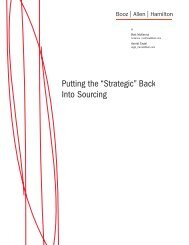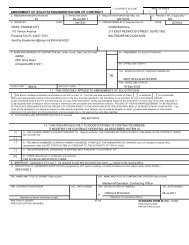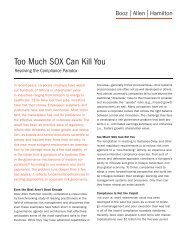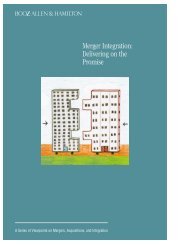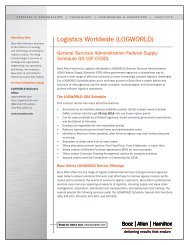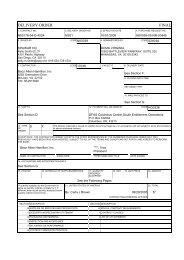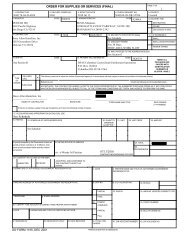Building the Enterprise - Booz Allen Hamilton
Building the Enterprise - Booz Allen Hamilton
Building the Enterprise - Booz Allen Hamilton
- No tags were found...
You also want an ePaper? Increase the reach of your titles
YUMPU automatically turns print PDFs into web optimized ePapers that Google loves.
services. Fur<strong>the</strong>r, applying an enterpriseapproach will increase savings,result in substantial efficiencies andimprove outcomes in cross-governmentaladministrative functionssuch as <strong>the</strong> management of finances,human capital, information technology,procurement and real property.For example, HUD and <strong>the</strong> Departmentof Veterans Affairs (VA)have collaborated successfully on agoal of ending homelessness amongveterans by 2015. Under <strong>the</strong> directionof <strong>the</strong> departmental secretaries,teams have coordinated <strong>the</strong> use ofHUD vouchers for veterans to rentprivately owned housing and targetedVA services such as health care,mental health and substance abusetreatment, vocational assistance, andjob development and placement. Aninteragency team of executives fromVA and HUD leads <strong>the</strong> effort in tandem,providing <strong>the</strong> two departmentswith weekly updates on voucher use,along with detailed reports on <strong>the</strong>status and recent activity of everyveteran in <strong>the</strong> program. Both departmentshave cooperated to ensurethat resources are being properlydeployed and goals are being met.The homelessness initiativecame about because of <strong>the</strong> personalcommitment of two Cabinet secretaries,who sent a strong signalthat <strong>the</strong> issue was important, madeclear <strong>the</strong>y wanted <strong>the</strong>ir staffs to collaborateand sustained <strong>the</strong>ir commitmentto dealing in an integratedway with multiple issues affectingveterans. The administration reportedthat <strong>the</strong> program has resulted ina 17.2 percent decline in veteranshomelessness from January 2009through January 2012, even in <strong>the</strong>face of difficult economic conditionsand a growing veterans population.We need to institutionalize thisapproach as a way of doing businessand make sure it is sustained and notdependent on <strong>the</strong> personality andgoodwill of Cabinet secretaries, whoafter several years may depart andleave cross-agency initiatives withouta champion.What we propose is not withoutprecedent or foundation. The seedsof an enterprise approach to governmentcan be found in <strong>the</strong> GovernmentPerformance and ResultsAct of 1993 (GPRA) and its progeny,<strong>the</strong> Government Performance andResults Modernization Act of 2010(GPRAMA). Toge<strong>the</strong>r, <strong>the</strong>se statutesprovide a basis for agencies to worktoge<strong>the</strong>r in a more coordinated andcross-cutting way.GPRA is a watershed law that for<strong>the</strong> first time required agencies to setconcrete performance goals, developstrategic plans to achieve thosegoals, measure <strong>the</strong>ir performance“We need an approach thatis as adaptive and flexibleas <strong>the</strong> challenges it isdesigned to overcome.”against <strong>the</strong>m, and report <strong>the</strong>ir progressto Congress. It also required <strong>the</strong>Office of Management and Budget(OMB) to craft a government-wideperformance plan to provide a perspectiveacross agencies. OMB didso, issuing plans in 1998 and 1999 aspart of <strong>the</strong> federal budget process,but <strong>the</strong> initiative was subsequentlyabandoned. As one government expertnoted, <strong>the</strong> government-wideplan was “a document in search ofan audience” because “no one feltownership” in <strong>the</strong> executive branchor in Congress.Times have changed. GPRAMAlaid <strong>the</strong> foundation for an enterpriseapproach to government byrequiring <strong>the</strong> White House to identifyand establish a small number ofhigh-priority cross-agency policyand management goals (see followingpage) and to name goal leadersto coordinate <strong>the</strong> activities of <strong>the</strong>multiple programs and agencies thatmust work toge<strong>the</strong>r to achieve commonobjectives.The good news is that agenciesand programs have set targets tomeet <strong>the</strong> overall cross-agency policygoals. These goals have includedenergy efficiency, job training andveterans’ career readiness, as well asmanagement initiatives such as reducingoverpayments and strategicsourcing. While progress has beenmade, initial outcomes have beenspotty. High-level administration attentionhas been missing, and absent<strong>the</strong> necessary infrastructure to operationalizeand sustain that attention,<strong>the</strong> stove-piped nature of governmenthas remained fully intact.The administration now has agreat opportunity. Without <strong>the</strong> needfor additional legislation, it can makeenterprise government a reality byexpanding and institutionalizing it,giving it teeth through strong seniorleadership engagement and commitment,and creating a managementinfrastructure.BUILDING THE ENTERPRISE 5





